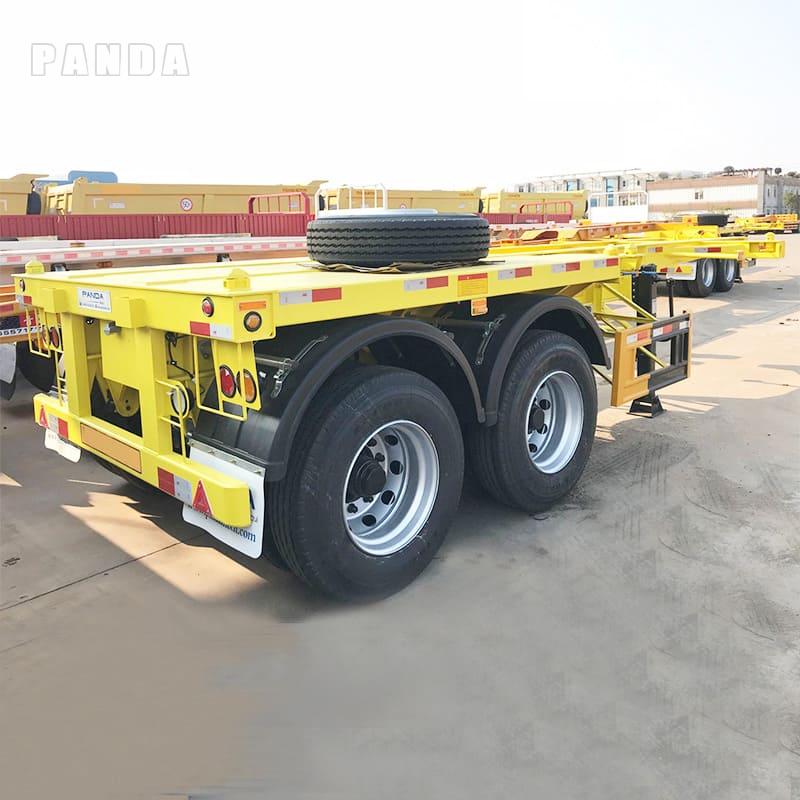Hello, my friend, this is Panda Mech, we meet again. When I was chatting with a customer the other day, he came across a question, what is a shipping container trailer?
As a professional shipping container trailer manufacturer, I have compiled a lot of information to help you have a better understanding of shipping container trailers, including their type, spec, usage, and price, hope it can help you.
1. What is a shipping container trailer?
Container trailer is mainly used to transport containers, which is one of the safest and fastest ways to transport a large amount of goods.
For different countries and regions, the requirements for container trailers are not quite the same, so we produce different types of container trailers, including height, capacity, load capacity, and so on.
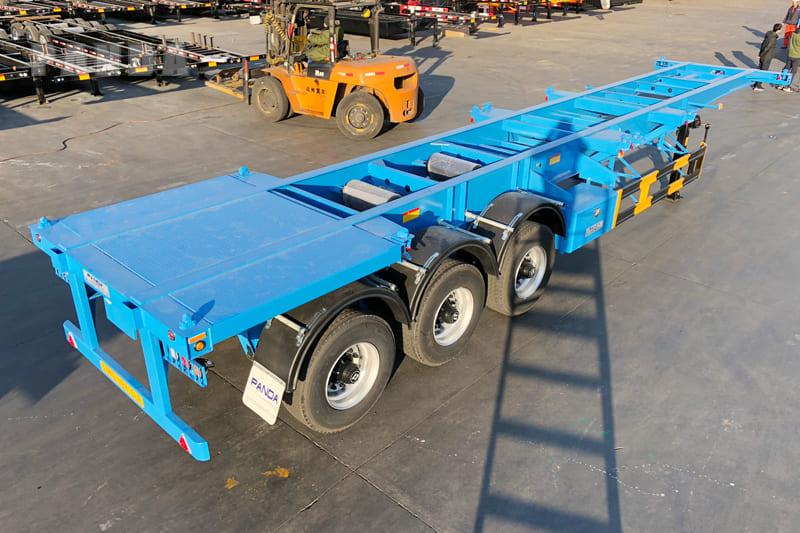
2. Different types of shipping container trailer
Shipping container trailer is generally categorized into three types which are container chassis trailer, flatbed container trailer, and container side lifter trailer.
Today we are going to introduce these three different types of shipping container trailers, and we also have a more detailed article on each of these three different types of container trailers.
2.1 Shipping container chassis
The container chassis trailer is a basic structure that can be used to load 10ft, 20ft, and 40ft containers.
Container chassis trailers are available in 20ft, 40ft, 45ft, 2 axles, 3 axles, and 4 axles. The most commonly used is the 3 axle 40ft container chassis trailer.
Specification of 20ft shipping container chassis
| Dimension | 7500*2500*1550mm |
| Height | 1550mm |
| Width | 2500mm, 8′ |
| Weight | 3700Kg, 8,000 lbs |
| Main Beam | “I” Section 500mm height Q345/T700 material |
| Twist-Lock | 4/8 set ISO Standard |
| Suspension | Mechanical / Air / Bogie |
| Axle | 2 axles BPW/FUWA/PDME etc |
| Rim | 8/12 pieces 9.0-22.5 Steel/Aluminum |
| Tire | 8/12 pieces 12R22.5 Bridgestone/Triangle/Linglong etc |
| Brake Valve | WABCO |
| Brake Chamber | 4/6 sets, T30/30 |
| Air Tank | 28L |
| Brake Pipe | Nylon Wire Pipe |
| Landing Gear | 28T Lifting JOST/YAHUA |
| Kingpin | 2″(50mm)/3.5″(90mm) JOST Bolting Type |
| Lights | 12v/24v LED Waterproof |
Specification of 40ft shipping container chassis
| Dimension | 12500*2500*1550mm |
| Weight | ≥6500Kg |
| Main Beam | “I” Section 500mm height Q345/T700 material |
| Twist-Lock | 4/8 set ISO Standard |
| Suspension | Mechanical / Air |
| Axle | 3 axles, BPW/FUWA brand |
| Rim | 8/12 pieces 9.0-22.5 |
| Tire | 8/12 pieces 12R22.5 Bridgestone/Triangle/Linglong etc |
| Brake Valve | WABCO |
| Kingpin | 2″(50mm)/3.5″(90mm) JOST Bolting Type |
Feature of shipping container chassis
- Simple structure.
- Economical.
- High strength and rigid structure.
- Different models, different sizes, different configurations.
- Often used in container transportation.
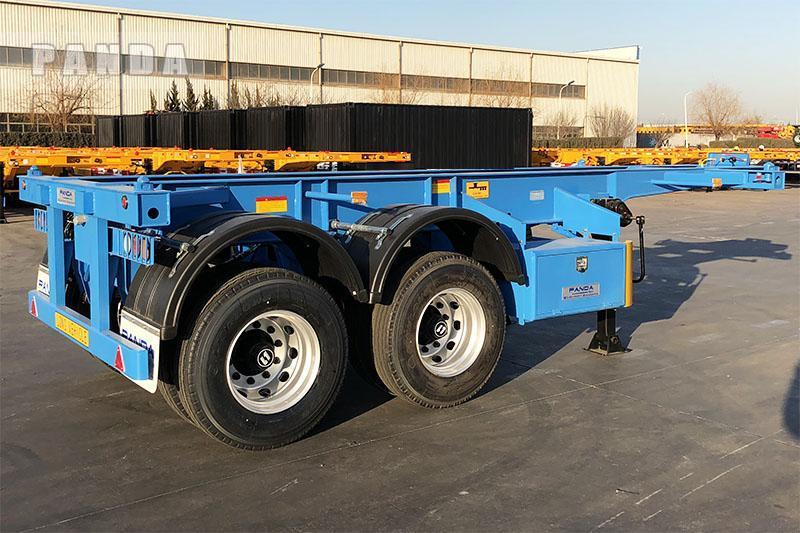
How much is a container chassis trailer?
20Ft: $6,800 – 12,600
40Ft: $8,400 – 15,600
45Ft: $8,500 – 16,500
2.2 ISO tank container trailer
ISO tank container trailer is mainly used to transport iso tank container.
20Ft ISO tank container chassis, also named ISO tank chassis trailer. Generally used for transporting ISO containers in ports, shipyards, routes, bridges, tunnels, and transfer stations, supporting multimodal transport logistics systems.
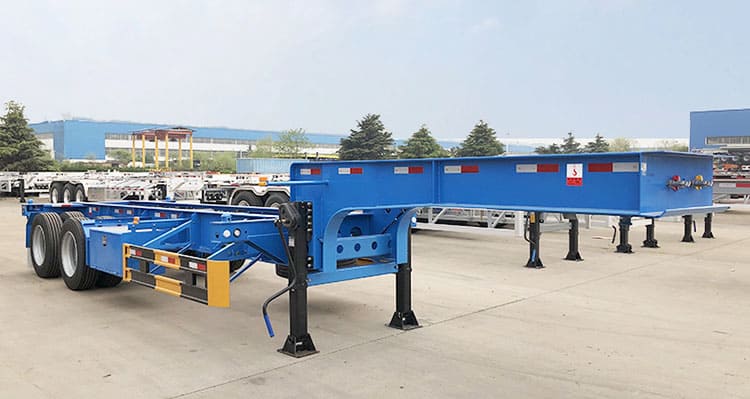
Specification of ISO tank chassis
| Dimension | 7500*2500*1200-1550mm |
| Height | 1200mm, 1550mm |
| Width | 2500mm |
| Skeletal trailer weight | 5600Kg |
| Main Beam | “I” Section 500mm height Q345/T700 material |
| Twist-Lock | 4/8 set ISO Standard |
| Suspension | Mechanical / Air / Bogie |
| Axle | 3 axles BPW/FUWA/PDME etc |
| Rim | 8/12 pieces 9.0-22.5 Steel/Aluminum |
| Tire | 8/12 pieces 12R22.5 Bridgestone/Triangle/Linglong etc |
| Brake Valve | WABCO |
| Brake Chamber | 4/6sets T30/30 |
| Brake Pipe | Nylon Wire Pipe |
| Landing Gear | 28T Lifting JOST/YAHUA |
| Kingpin | 2″(50mm)/3.5″(90mm) JOST Bolting Type |
| Lights | 12v/24v LED Waterproof |
How much does ISO tank chassis?
Price: $7,100-14,500.
2.3 Extended container trailer
As the name suggests, the length of the extended container chassis is variable, the benefit of this is that whether it’s a 10ft, 20ft, 40ft container, the extended container chassis can be perfectly transported, it’s extendable from the rear, and when the extended container It is extendable from the rear and when the extended container chassis is contracted, it is as short as the normal model.
Place the load at the center of the trailer floor to maintain balance. Filling the floor lengthwise makes loading simpler.
Although longer trailers can cause city traffic issues, they provide versatile solutions for transporting various types of cargo.
How much does an extended container trailer?
Price: $7,500-18,500.
2.4 Gooseneck container chassis
The Gooseneck container chassis is a robust framework that includes various components: the frame assembly, suspension and braking systems, electrical setup, and travel mechanisms.
The frame itself has a gooseneck section, which links the mounting area to the carrying section. When the chassis is placed flat, the height of the carrying section is at min 1,350mm from the ground. This section features two crossbeam assemblies, spaced 11,989mm apart. Each assembly also has two locking devices with a width distance of 2,260mm between them. (Guide of gooseneck container chassis)
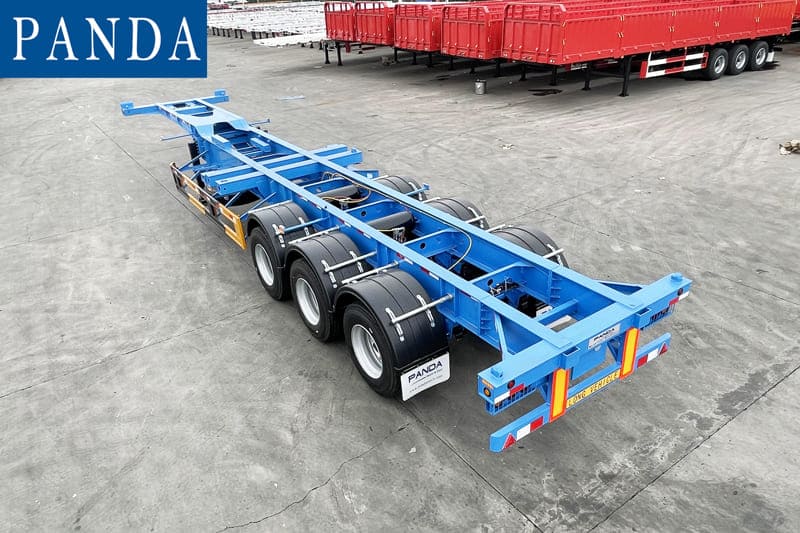
Specification of gooseneck container chassis
| Dimension | 12500*2500*1400-1550mm |
| Height of skeletal trailer | 1400 – 1550mm |
| Width | 2500mm |
| Skeletal trailer weight | 5600Kg |
| Main Beam | “I” Section 500mm hieght Q345/T700 matirial |
| Twist Lock | 12/14 set ISO Standard |
| Suspension | Mechanical / Air / Bogie |
| Axle | 2/3/4 axles BPW/FUWA/PDME etc |
| Rim | 8/12/16 pieces 9.0-22.5 Steel/Aluminum |
| Tire | 8/12/16 pieces 12R22.5 Bridgeston/Triangle/Linglong etc |
| Brake Valve | WABCO |
| Brake Chamber | 4/6/8 sets T30/30 |
| Brake Pipe | Nylon Wire Pipe |
| Landing Gear | 28T Lifting JOST/YAHUA |
| Kingpin | 2″(50mm)/3.5″(90mm) JOST Bolting Type |
| Lights | 12v/24v LED Waterproof |
How much does a gooseneck container trailer?
Price: $8,900-17,900
2.5 Flatbed container trailer
A 40-foot flatbed trailer is typically designed to carry 20 or 40-foot containers. These trailers are essential for a seamless transport chain, connecting ships, ports, highways, transit stations, bridges, tunnels, and even multimodal transport systems.
The loading area of the flatbed is tailored to fit standard container sizes. To secure the container, twist-lock devices are strategically placed at each of its four bottom corners.
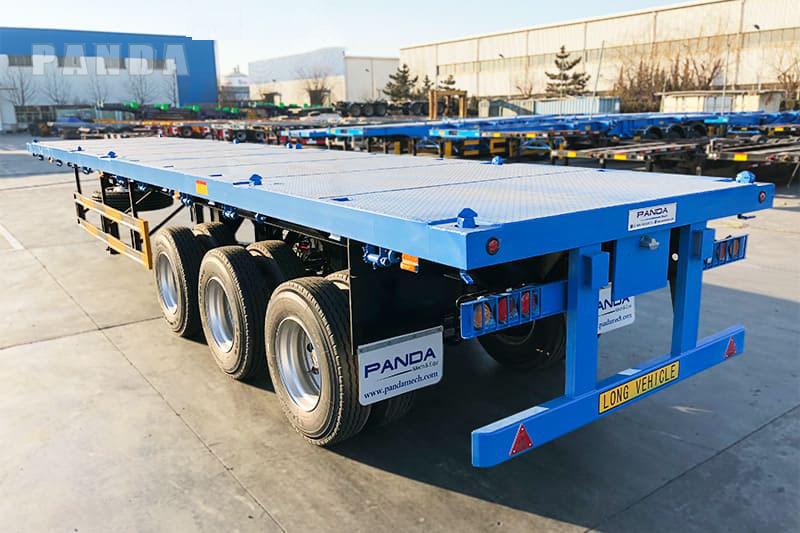
Specification of flatbed container trailer
| Manufacturer | Panda Mech |
| Axles | 3 axles, BPW/SAF/FUWA Brand |
| Dimensions | 12500×2500×1500 mm |
| Capacity | 70 ton |
| Weight | 7-9 ton |
| Twist lock | 8-12 sets |
| Material | Main beams Q345B, upper flange:14mm, middle:8mm, down:16mm |
| King Pin | 2 inch or 3.5 inch JOST Brand |
| Chassis | 3mm,4mm,6mm, carbon steel or aluminum alloy |
| Suspension | Mechanical, airbag suspension |
| Tire | 11.00R20, 12.00R20,12R22.5, 385/65R22.5 Triangle/Hankook/ Bridgestone brand |
Feature
A flatbed trailer is a versatile workhorse, not just limited to container transport. Its customizable features make it adaptable for a wide range of uses. Constructed with a lightweight yet sturdy cellular structure, the trailer efficiently distributes load forces, connecting seamlessly to essential components like the suspension system, kingpin, wheels, and landing gear.
This design brings significant value to the trucking industry by aligning with legal weight limitations. In fact, compared to traditional steel or aluminum frame trailers, it offers a weight advantage of approximately 4,000 and 2,500 pounds, respectively. This translates to increased payload capacity, enabling the trailer to carry loads up to the maximum legal weight limits globally.
How much does a flatbed container trailer?
$7,990-14,500
2.6 Container side loader
A sideloader, also known as a sidelifter or self-loading trailer, is a specialized vehicle equipped with dual hydraulic cranes for lifting and transporting containers. Operated by the driver through on-site controls or a remote, this versatile machine is a cornerstone in modern logistics, linking trucks, trains, and ground-level operations.
Its design allows for efficient container handling even in tight spaces, opening up new business opportunities in an ever-changing market. With minimal manpower and no need for additional equipment, a sideloader streamlines the entire transport process, enhancing both speed and competitiveness.
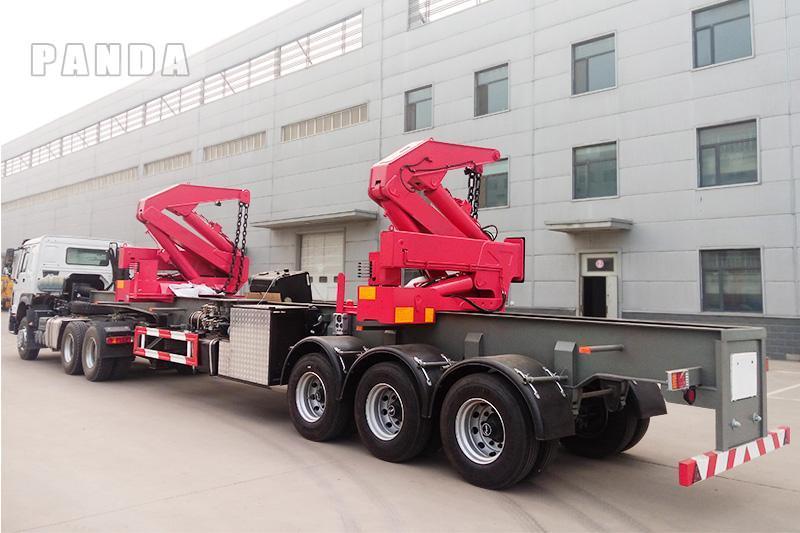
Specification of container side loader
Brand: PANDA Mech
Maximum lifting weight: 37 tons
Dimension:14200*2500*4200mm
Suspension: Mechanical
Axle:3
Tires:12pcs
Material: High strength steel
Crake: WABCO emergency valve
King pin: 2/3.5 feet
Landing gear: Jost
Power source: Power take-off/diesel APU
Operation mode: Wireless remote control and manual operation
How much does a container side loader trailer?
$30500-65,900
2.7 Container Tilt/Tipping trailers
The container tipping trailer offers a unique structure to streamline the loading and unloading process. Consisting of upper and lower frames connected by a pivot device, this trailer is ideal for operations where a crane isn’t available. A hydraulic cylinder elevates the upper platform, simplifying the loading procedure.
During offloading, the trailer tilts backward, allowing gravity to guide the container gently onto the ground. Once the container’s rear end makes contact, the truck moves forward, letting the container continue its descent.
In essence, a container tipping trailer functions similarly to a traditional tipper trailer, but without the tipping bucket, offering a practical and efficient solution for container transport.
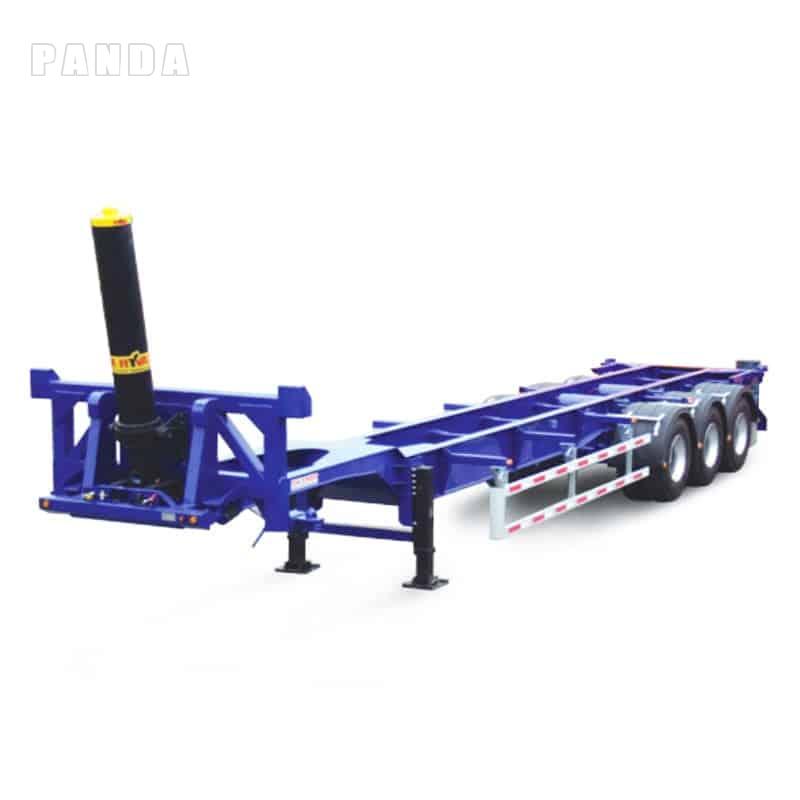
3. Container Lock
A crucial component of these trailers is the container lock, designed to securely attach the trailer chassis to the container body. The lock features a specialized cavity, a handle, and various other elements engineered for maximum security and ease of use.
The setup includes a handle connected to a sleeve that passes through a designated slot in the wall. This sleeve is affixed to a striker angle plate, designed to fit snugly into the slot in at least two different rotational positions. A shaft extension, connected to the sleeve at one end, stretches into the container cavity at the other end.
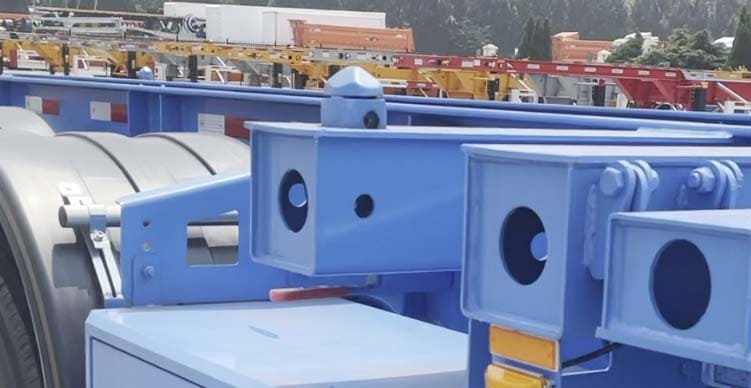
This system is further enhanced by a slip joint, linking the sleeve to the shaft extension, and a safety locking plate with an elongated design to reinforce the entire locking mechanism.
This intricate yet user-friendly design ensures that your container stays securely attached to the trailer, providing both safety and peace of mind.
Feature:
The primary goal of this invention was to create a chassis lock that offers easy operation while ensuring a secure connection between the container body and the trailer chassis. Additionally, the design aimed to make the lock simple to maintain and assemble as needed.
Constructed with minimal yet effective parts, the lock is built for reliability and low-maintenance operation. A standout feature is its ability to lock into the desired position using gravitational force, offering a fail-safe method to secure the container. This design strikes a balance between simplicity and effectiveness, providing a robust yet easy-to-use locking solution.
4. How to choose the right shipping container trailer?
Selecting the right type of trailer hinges on several key factors tailored to the specific job you have in mind. Here’s what you need to consider:
Weight Capacity Requirements:
All trailers are designed to carry substantial weight, but if you’re dealing with particularly heavy containers, the 2-axle or 3-axle container chassis trailer is your best bet. Engineered specifically for high-weight loads, it offers adjustable features to meet your requirements for loading, offloading, and axle spacing.
Number of Axles:
Your cargo’s weight will also dictate the number of axles you’ll need. Options generally range from 2 to 3 axles, as the maximum weight capacity for a container is 30 tons. For example, flatbed trailers can accommodate varying axle assemblies along their length, offering more flexibility.
Application:
If you need a trailer for transporting diverse types of cargo beyond containers, a flatbed trailer is the most versatile option. On the other hand, if your operations involve loading and offloading at inclined positions, a container tilt trailer would be most suitable.
Price:
Cost is another major consideration. If your needs are basic, opting for a more expensive container tilt trailer may not be cost-effective. Its higher price is largely due to its advanced lifting system. In such cases, a flatbed or container chassis would suffice.
Your choice should align with these considerations to ensure you’re making the most informed and efficient decision.
Conclusion
Well, today our article ends here, I believe that after you read it, for shipping container trailer has a more in-depth understanding of it, if you for shipping container trailer there are other aspects of the problem, we welcome you to contact us at any time to consult us.
FAQ
How to secure a container to a flatbed
There are 8-12 locks on top of each flatbed, and the container can be fixed to the flatbed by means of the locks.
Container chassis height from ground
1500mm, 1.5 meter.
Can you put a shipping container on a trailer?
Yes, by container torque, we can easily fix the container on container chassis.
How much does a 20′ shipping container weigh
Typically an empty 20 foot shipping container weighs between 1.8-2.2 metric tonnes (about 3,970 – 4,850 lb) and an empty 40 foot shipping container weighs 3.8 – 4.2 tonne (8,340 – 9,260 lb) depending on what kind of container it is. For example, high cube containers tend to be heavier.
How to transport a shipping container
The best way to move containers is to use a container chassis or flatbed semi trailer.
Standard iso tank container specifications
Present day the container dimensions have standardized to an international standard size of 20′ long, 8′ wide and 8’6” high.

